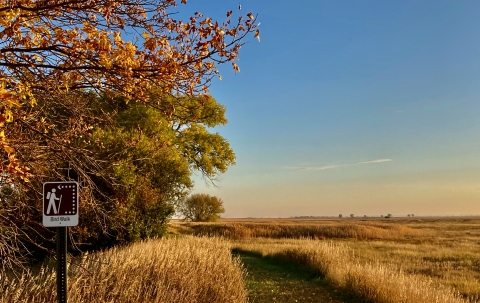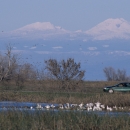Visit Us
Lacreek National Wildlife Refuge provides numerous recreation opportunities to thousands of visitors each year! People enjoy viewing the unique geology and diverse wildlife via boat, vehicle and foot. Enjoy trails, off-trail hiking, kayaking, wildlife viewing, bird watching, fishing and hunting. Visitors may picnic, camp and swim at the Little White Recreational Area. Regulation of recreational activities allow for public enjoyment of the Refuge while still protecting wildlife and habitat.
Click here for a PDF version of the Refuge brochure.
Lacreek National Wildlife Refuge
Headquarters Address:
29746 Bird Road
Martin, SD 57551
Phone: 605-910-7086
Email: lacreek@fws.gov
Activities
Lacreek National Wildlife Refuge provides numerous recreational opportunities to thousands of visitors every year. People enjoy viewing the unique geology and diverse wildlife, whether boating, driving or hiking. Regulation of recreational activities allow for public enjoyment of the Refuge while still protecting wildlife and habitats. Typically there aren't any closed areas to foot traffic on the Refuge, but seasonal or temporary closures may occur. If you come across a closed area, please respect it to minimize disturbance to plants and animals.
Trails
We have two established birding trails, the Bird Walk next to the Visitor Center, and the Pelican Island trail. Please feel free to explore the Refuge on foot in any area open to the public, including the Sandhills!
Pick up a Refuge brochure at one of our two kiosks for a map.
Other Facilities in the Complex
Lacreek National Wildlife Refuge is included in the Sandhills National Wildlife Refuge Complex which includes Fort Niobrara, Valentine, Crescent Lake, North Platte and John W. and Louise Seier National Wildlife Refuges. Lacreek National Wildlife Refuge is the only station located in South Dakota, with the remaining stations located in Nebraska.
Fort Niobrara National Wildlife Refuge was once a frontier military fort, supports an exceptional diversity of plants and wildlife representative of the northern Great Plains and geographic regions east, west, north, and south of here. In the early 1900s, President Theodore Roosevelt and private conservation organizations, such as the National Audubon Society and American Bison Society, were becoming increasingly concerned with the exploitation of wildlife and their habitats on the Great Plains and elsewhere. As a result, an Executive Order was signed on January 11, 1912, establishing Fort Niobrara as a "preserve and breeding ground for native birds." Later that year, the Refuge's purpose was expanded to include the conservation of bison and elk herds representative of those that once roamed the Great Plains.
Valentine National Wildlife Refuge is 71,516 acres and is located in the Sandhills of north-central Nebraska. The Refuge is a unique and ecologically important component of the National Wildlife Refuge System (System) which includes more than 566 National Wildlife Refuges spanning approximately 100 million acres of lands and 750 million acres of oceans in the United States. The native grass prairie and wetlands found here support a diversity of wildlife. Little has changed from historic times. The Refuge was established by Congress in 1935 “as a breeding ground for migratory birds and other wildlife.” The Refuge is home to 270 species of birds, 59 species of mammals, and 22 species of reptiles and amphibians.
Crescent Lake National Wildlife Refuge lies on the southwestern edge of the Nebraska Sandhills, the largest sand dune in the Western Hemisphere. The Sandhills are characterized by rolling, vegetated hills and interdunal valleys. These habitats on the Refuge are interspersed with 21 wetland complexes—shallow lakes, marshes, seasonal wetlands, wet meadows, and a small stream. Wildlife diversity, except large ungulates and their predators, is relatively unchanged since early settlement.
North Platte National Wildlife Refuge was established in 1916 by Executive Order No. 2446 as a “preserve and breeding ground for native birds.” It is located in the Nebraska Panhandle, near Scottsbluff. It was declared a National Wildlife Refuge primarily because of fall concentrations of up to 250,000 Mallards, 11,000 Canada Geese and Bald Eagles.
John W. and Louise Seier National Wildlife Refuge is found in north-central Nebraska, as a sanctuary among the Sandhills. The Sandhills region is the largest remaining tract of mid and tall grass prairie in North America. The Seier Ranch was originally homesteaded by John and Louise Seier’s grandparents in the mid-1800's. John and Louise Seier did not have any immediate family, but did have a love of wildlife and an interest in preserving wildlife, they donated, their 2,400 acre working cattle ranch to U.S. Fish and Wildlife Service in October of 1999. Because the Refuge is so new to the System, it remains closed to the public at this time. There is no projected date for the opening of the Refuge, however, a date will be established upon the completion of a management plan.
Rules and Policies
There are lots of fun, interesting, and educational things you can do on Lacreek National Wildlife Refuge. Keep in mind, if an activity is not wildlife related and doesn’t help in the protection or understanding of wildlife or their habitat, there are likely Refuge rules governing this activity. Important regulations include the following:
- The Refuge is open from sunrise to sunset.
- Roads throughout the Refuge are graveled and visitors must maintain the posted speed limit of 25 miles per hour.
- No overnight parking is allowed on the Refuge except for Little White River Recreation Area.
- The non-wildlife dependent activities of boating, picnicking, and camping are only allowed at the Little White River Recreation Area.
- Hiking is allowed in all areas open to the public.
- Wildlife observation and photography are encouraged.
- Please stay out of closed areas to minimize disturbance to plants and animals.
- Bicycling and horseback riding is allowed on signed Refuge public access routes open to motor vehicles.
- Fishing is allowed on all Refuge waters in accordance with state regulations.
- Sport hunting is permitted on the Refuge in accordance with all state and federal regulations. Hunters should consult the South Dakota state hunting regulations. Special Refuge hunting regulations also apply.
- Firearms and other weapons are subject to state law. At all times, persons possessing, transporting, or carrying firearms on National Wildlife Refuge System lands must comply with all provisions of State and local law. Persons may only use (discharge) firearms in accordance with refuge regulations (50 CFR 27.42 and specific refuge regulations in 50 CFR Part 32), i.e., only during the lawful pursuit of game during legal seasons.
- Other prohibitions on the Refuge are dogs off-leash; off-road vehicles; alcoholic beverages; and collecting of plants, animals, minerals, antlers and artifacts.
- Travel by motor vehicle is allowed only on designated roads.
- Hunters must park in a designated hunter parking area while participating in hunting activities. Please check with the Refuge manager for further details.
Locations
We invite you to visit Lacreek National Wildlife Refuge to explore the wetlands and sandhills, and enjoy the wildlife that calls them home!
Lacreek NWR is located directly north of the Nebraska/South Dakota border approximately 15 miles southeast of Martin, South Dakota, and about 120 miles southeast of Rapid City. There are many routes to the Refuge, but no matter which path you take, you'll be treated to the sights and sounds that western South Dakota and north-central Nebraska have to offer. Drive safely and enjoy your visit!
Headquarters Address:
29746 Bird Road
Martin, SD 57551
Phone: (605) 910-7086
Email: lacreek@fws.gov
Refuge Manager:
Todd Schmidt
(605) 910-7086
todd_schmidt@fws.gov
Located about 15 miles northwest of the Lacreek National Wildlife Refuge, the town of Martin (pop. 1,150) is the nearest town to the Refuge. Martin is the county seat for Bennett County and offers many visitor services to make your stay more enjoyable. Included in these services are medical facilities, restaurants, motel lodging, and veterinary services. Several gas stations, a grocery store, and hardware stores, among others, are also available to help meet your needs during your visit. For further information, you may call the Martin City offices at (605) 685-6525 or e-mail them at martinsd@gwtc.net. Click here to view the general Refuge location. Please be advised that GPS directions may direct you to take roads that do not exist, or may not be public roads. Lacreek NWR is located about 120 miles southeast of Rapid City in southwestern South Dakota. If you are coming from the Rapid City area, there are several ways to get to the Refuge. First, you may take Interstate 90 east to Kadoka (exit 150). Turn right and proceed south on Highway 73 to the Highway 18 junction. From the junction, take a left and go about 1 mile to 231st Avenue; turn right on the gravel road. Head south 4 miles to the small town of Tuthill. Take a right on 293rd St. at Tuthill and go 1 mile. You will now be at the northeast corner of the Refuge -- look for the information kiosk. Take a left toward the kiosk on a gravel road, and travel about six miles to reach the Headquarters/Visitor Center. Once past the prairie dog town, you are almost there. Follow the signs to Headquarters and look for the Refuge’s fire tower. If you are coming from eastern South Dakota, the easiest route is to take Interstate 90 to the Kadoka exit and follow the above-mentioned directions to the Refuge. For visitors coming from Nebraska, the easiest route is to follow Highway 20 to Highway 61 in Merriman, Nebraska. Take Highway 61 north into South Dakota and look for the Refuge sign along the highway pointing you towards the Refuge. This road is 297th St. and is approximately 13.5 miles from Merriman. Take a right at 297th St. and go 8 miles to the Headquarters/Visitor Center. Another route to the Refuge from Rapid City (route #2), which takes you through a portion of the Badlands National Park, is to head out Highway 44 past the airport to Scenic, SD. From Scenic, go south to Sharps Corner, and continue south to the Highway 18 junction 10 miles east of the town of Pine Ridge. Take a left and it's about 35 miles to Martin. From Martin, take a right on Highway 73 and just follow the posted signs. Just in case a sign is missing, go approximately 4 miles south, turn left onto the gravel road, go 1 mile east, then turn right and go 1 mile south, then take a left and go 7 miles east. This will take you directly to the Refuge Headquarter. Be on the lookout for deer and pheasants along the gravel roads. No matter which direction you come from, you will be treated to the sights and sounds that western South Dakota and north-central Nebraska have to offer. Drive safely and enjoy your visit! |









